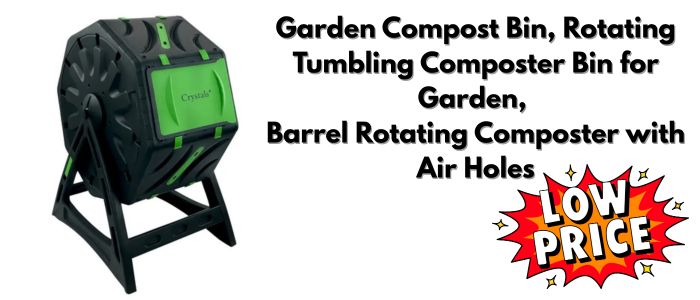Unlocking Better Composting with Temperature Secrets
What if your compost could talk?
With the right tools, it sort of can. The sneaky science of compost thermometer readings lets you peek into what’s really happening deep in your pile.
Understanding these temperature changes can make a world of difference for anyone learning about composting, using a compost tumbler, or going all-in with vermicomposting.
Temperature isn’t just a number—it’s a clue. A compost thermometer shows if your pile is too cold for microbes to work, or hot enough for quick composting.
You’ll soon see how these simple readings take a lot of the guesswork out of making great compost, whether you’re just starting out or you’ve tried different methods before.
To keep your process smooth and efficient, knowing the right frequency of turning compost helps even more.
Get ready for some practical insights.
We’ll uncover how a humble thermometer can reveal what’s cooking in your compost—and help you turn food scraps and yard waste into garden gold faster than you might expect.
Why Compost Thermometers Matter: More Than Just a Number
A compost thermometer isn’t just a tool—it’s your window into all the hidden action happening in your compost pile or compost tumbler.
Glancing at that number gives you real clues about the pace and health of the breakdown process, whether you’re managing a heap, turning a tumbler, or even trying your hand at vermicomposting.
The sneaky science of compost thermometer readings goes well beyond curiosity; it’s about making informed choices to help your compost work smarter, not harder.
Let’s take a look at why those readings are so important.
How Heat Fuels Composting Magic
 Photo by Dino
Photo by Dino
Heat in compost isn’t just about warmth—it’s the side effect of busy microbes feasting on your scraps and leaves.
When you see the thermometer climb, that’s the magic at work. Microorganisms—tiny creatures like bacteria and fungi—gobble up organic material, creating energy and a burst of heat.
- Higher temperatures = Supercharged composting. With the right balance of green and brown material, microbial activity spikes, and the pile quickly heats up.
- Peak heat usually means pathogens and weed seeds are being destroyed, making your final compost safer for your garden.
- Cooler stretches suggest the microbes are slowing down, either because food is running low or conditions (like moisture or air) aren’t quite right.
The microbial breakdown process is the secret behind the thermometer’s dance.
If you’re curious about the science, Compost Physics by Cornell breaks down why microbial munching kicks off so much heat and what the temperature swings really mean.
What Do the Numbers Actually Mean? Interpreting Compost Thermometer Readings
Spotting 100°F or 150°F on your compost thermometer isn’t just for trivia. Each number tells a story about what’s happening deep inside the pile.
Let’s break down what common temperature ranges mean and what they ask you to do:
- Ambient-80°F (Cool): The pile has just been set up, or microbial activity is slow. If it stays here, your pile needs more green stuff (like food scraps or grass clippings) or some extra turning for airflow.
- 90-130°F (Warm/Active): The microbes are busy, and things are moving along nicely. This is where regular composting sits. If you’re using a compost tumbler, keep giving it a spin for best results.
- 131-160°F (Hot/Optimal): The real hot zone. Fastest breakdown, best for killing off unwanted seeds or germs. Turning your pile when it starts to cool will help keep the temperature up. Avoid letting it climb above 160°F—microbes start to tap out when it’s too hot!
- Above 160°F: Time to add more browns (dry leaves, cardboard) or let the pile breathe a bit. A pile this hot can dry out or slow the process, not speed it up.
Here’s a quick reference table for temperature and compost meaning:
| Temperature (°F) | Compost Activity | What To Do |
|---|---|---|
| <80 | Slow/Cool | Add greens, check moisture |
| 90-130 | Active | Maintain, turn as needed |
| 131-160 | Hot/Optimal | Turn, monitor moisture/heat |
| >160 | Overheating | Add browns, aerate, cool down |
For even more hands-on tips about reading and reacting to these numbers, the Compost Thermometer Guide from Compost Magazine is a great resource.
If you want to get the most from your efforts—whether that’s slowing down or speeding up the batch, or adapting things for vermicomposting—a thermometer helps you know what’s working and what needs a tweak.
And if you’re curious about how to troubleshoot other composting hiccups or dive deeper into best practices, check out this instant composting advice tool for quick answers.
The real beauty of the sneaky science of compost thermometer readings is that a simple number makes you the boss of your pile.
Temperature isn’t just a stat. It’s an early warning signal and a pat on the back, all rolled into one.
Decoding the Compost Pile: The Science Behind the Sneaky Readings
Peeking inside your compost pile is a bit like being a plant detective. The sneaky science of compost thermometer readings doesn’t just show numbers—it tells the story of your pile’s tiny residents, what method you’re using, and even warns you when something’s off.
Understanding what shapes these readings helps you make smarter choices for happy, healthy compost, whether you’re using a compost tumbler, a simple backyard heap, or practicing vermicomposting with worms.
The Role of Microbes and Decomposers
 Photo by Dino
Photo by Dino
When you see the temperature rise in your compost, thank the microbes and decomposers. These tiny organisms are your team of janitors, cooks, and recyclers.
Bacteria, fungi, and other microbes munch through food scraps, leaves, and garden clippings. This busy eating and breathing creates heat—essential for the breakdown process.
- Mesophilic microbes: These are the “early birds” in compost, kicking off the action at cooler temps (up to about 104°F).
- Thermophilic bacteria: As things heat up, these take over, driving temperatures into the “hot” zone (110-158°F), which is great for quick composting and zapping weed seeds.
The mix of green materials (like food scraps for nitrogen) and browns (like leaves for carbon) feeds these microbes.
Curious how this works? Cornell’s Compost Microorganisms overview explains the different types that lead the charge at each stage. When microbes munch, they multiply, and that sets off the heat wave your thermometer catches—like a secret signal that things are really cooking.
Compost Tumblers vs. Traditional Piles vs. Vermicomposting: Temperature Differences
The method you use makes a big difference in what your thermometer reveals. Each setup creates its own “climate zone” for the hidden workers inside.
Compost Tumblers:
- Closed containers that you roll or spin.
- Trap heat well, so they heat up quickly.
- Easy to turn and aerate, so they stay active—but they can also dry out faster if you’re not careful.
Traditional Piles:
- Open heaps right on the ground.
- More space for bugs, worms, and even air to slip in.
- They might not hold heat as tightly but can reach higher temps if you have a large pile.
Vermicomposting:
- Uses worms to break down food scraps, usually in bins indoors or shaded spots outside.
- Stays much cooler—worms like it below 85°F.
- Doesn’t cook like other methods, so you won’t see high readings, but you get super-high-quality finished compost.
Each style tells a different story on your thermometer. If you want more on which method fits your needs, check out advice for choosing a composting method that matches your lifestyle.
Troubleshooting Unusual Temperature Patterns
Ever checked your compost and found the temperature’s “off”—either way too cold or hotter than expected? Don’t worry.
Most temperature swings have a simple fix.
Here’s what can cause surprising numbers on your compost thermometer:
- Pile too small or dry: Small piles and dry heaps lose heat fast. Add more greens and browns, and sprinkle a little water if it feels dusty.
- Too many browns, not enough greens: Without enough nitrogen-rich food, the microbes nap, and the heat drops. Add kitchen scraps or fresh grass clippings.
- Pile too dense or wet: When compost is soggy, there’s no room for oxygen. Microbes gasp, and the pile cools. Loosen it up and add dry browns.
- Weather: Cold weather can cool your pile overnight.
If your compost gets hot too fast, it can be a sign things are crammed too tightly, drying out, or there’s just too much of one material.
Take a look at this thorough guide, Compost Troubleshooting Guide from UConn, for step-by-step solutions.
For more practical tips on maintaining the best compost temperature and how to fix a stall, there’s a handy article on why a compost pile might not get hot.
The trick is to keep an eye on that thermometer and know your method’s quirks—then adjust your ingredients or moisture as needed.
Keep in mind, each temperature swing is another clue in the sneaky science of compost thermometer readings.
Learn to read these hints, and even a stubborn pile will start working with you, not against you.
If you need quick troubleshooting, try the instant advice tool for instant composting fixes the next time you spot a reading that makes you scratch your head.
Making the Most of Your Compost Thermometer: Simple Steps for Success
Reading a compost thermometer isn’t tricky, but getting the most accurate and helpful results can feel like reading secret messages from your compost pile.
Whether your system is a backyard heap, a compost tumbler, or a worm-filled bin for vermicomposting, following a few smart steps can boost your confidence.
Here’s how to lend the “sneaky science of compost thermometer readings” some extra accuracy and turn every measurement into meaningful action.
Tips for Consistent and Accurate Thermometer Use
 Photo by Dino
Photo by Dino
If you’ve ever wondered why your compost thermometer shows different numbers each time, you’re not alone.
Measuring compost is like checking the weather—you want to compare apples to apples.
Here are straightforward ways to get reliable readings:
- Choose the right spot: Always insert your thermometer deep into the center, not just the top layer. The core is where the true action happens.
- Wait for it to settle: Leave the thermometer in for a couple of minutes. Give it time to adjust and show a stable temperature, instead of snatching a quick snapshot. For even more tips, see this compost thermometer guide.
- Stick with a routine: Take readings at the same time of day for better comparison. Morning temperatures can differ from late afternoon, just like with soil or air.
- Clean the stem: Wipe your thermometer’s stem after each use, so leftover debris doesn’t interfere with new readings.
- Be consistent with placement: Always take readings from the same depth and general area, especially in a compost tumbler or pile that might have “hot spots.”
If you’re curious about tips from other compost makers, this discussion on reliable thermometer readings shows that patience and good habits pay off.
Sticking to these steps will give you a real-time, accurate look at how your compost is doing. That way, every number tells you something new about your pile’s health and speed.
Adjusting Moisture, Green/Brown Ratio, and Aeration Based on Readings
Once you’re reading your compost thermometer confidently, you hold the keys to top-speed composting—no guessing required.
The numbers point you right to what your pile wants next, whether you’re working with a backyard heap, a compost tumbler, or diving into vermicomposting.
If your readings are off:
- Too Cold: Add more nitrogen-rich greens (like kitchen scraps or grass clippings). Mix and moisten the pile; warmth loves moisture.
- Getting Low Moisture: Your compost should feel like a wrung-out sponge—damp but not soggy. If it’s too dry or dust rises, sprinkle water and mix. For handy moisture tricks, this quick read on managing moisture in your compost pile makes it simple.
- A Little Hot: Check your balance. Too many greens can overheat a pile. Add dry browns (leaves, shredded paper) and mix for airflow.
- Persistent Cool: This could mean packed material or lack of air. Fluff the pile to add oxygen, and consider if the heap needs to be bigger for proper insulation. Turning your pile helps mix air throughout, as explained in this article on turning for quick composting.
- Vermicomposting: High heat might signal you need to move worms or adjust feedings since worms prefer temperatures below 85°F.
Here’s a cheat sheet for reacting to your thermometer:
- Temperature drops: Add greens or moisture. Stir it up.
- Temps above 160°F: Add browns. Increase airflow.
- Stays damp and smelly: Too much moisture. Add browns and fluff it.
Internal numbers give you a voice from inside the pile. Use temperature, feel, and smell as clues and tweak one thing at a time.
Don’t be afraid to try small changes—compost is forgiving, and each adjustment powers up the sneaky science of compost thermometer readings.
For more support on troubleshooting pile hiccups and dialing in your compost recipe, give the composting FAQ bot a try.
It’s great for finding fast solutions, whether you’re using a compost tumbler, traditional pile, or venturing into vermicomposting.
Conclusion
The sneaky science of compost thermometer readings gives every composting setup—heap, tumbler, or vermicomposting bin—a way to “talk back.”
Knowing why the number moves, and what to do with that information, puts healthy, finished compost within reach for anyone, even beginners.
Tracking your pile’s temperature takes the mystery out of composting. Try regular checks and watch how little changes—like turning the pile or adding kitchen scraps—boost your results.
Small tweaks really add up, whether you’re troubleshooting a slow batch or aiming for fast, hot compost with your tumbler.
Curious about different composting methods or want instant answers to your compost questions? Explore the composting FAQ bot for quick advice.
Give temperature tracking a try and discover how science can make your next garden project even more rewarding.
Thanks for reading. What will your thermometer tell you next?





